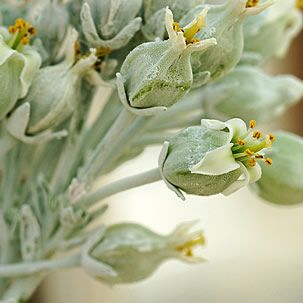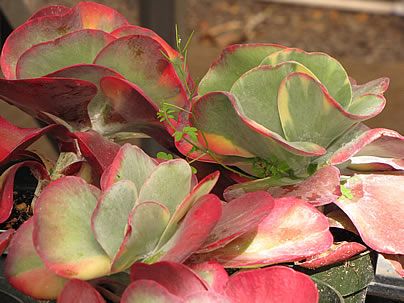The paddle plant (Kalanchoe tetraphylla) is a succulent that stands out for the shape, texture, and vibrant color of its leaves. Native to South Africa, it forms dense basal rosettes with its wide, rounded, glabrous, and succulent leaves, covered with a thin powdery waxy layer, white in color, which concentrates in greater quantity near the stem and inflorescences. This layer gives the plant a matte appearance, quite interesting.
Depending on the variety, ambient temperature, and level of sunlight, the leaves can be light green, bluish, or cream yellow with more or less red edges, in a delicate gradient. There are also cream variegated plants. After planting, the plants reach maturity between three to four years but can flower as early as two years, with long and erect terminal inflorescences emerging in the fall, which can grow to over one meter in height. The inflorescence of the paddle plant is a panicle of thyrses, with small, highly fragrant yellow flowers. After flowering, which can last up to a year, the plant dies, leaving many small seedlings that emerge from its base.

A find for rock gardens! The paddle plant adds interest with its unique colors and texture. Additionally, it is drought-tolerant, making it ideal for xeriscape gardens with low water availability. Use it in combination with other cacti and succulents, or as ground cover in sunny, foot-traffic-free areas. It can also be planted in pots and planters, in beautiful arrangements, thus decorating sunny balconies, patios, and terraces.
It should be cultivated in full sun or partial shade, in perfectly drainable, sandy soil, enriched with organic matter, and irrigated at spaced intervals. To obtain intensely red-toned leaves, expose the paddle plant to full sun, especially during the cold winter, when it reaches its greatest color intensity. Water abundantly only when the substrate is dry. Reduce watering in winter.
Highly sensitive to waterlogging, avoid substrates with high water retention capacity and never leave a saucer under the pot. Tolerant to coastal salinity. It can be propagated by seeds or leaf cuttings, left to heal for at least 24 hours before planting. Small seedlings that form around the mother plant can also be separated and replanted in another pot.


